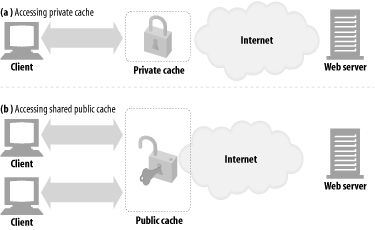HTTP: The Definitive Guide
by David Gourley, Brian Totty, Marjorie Sayer, Anshu Aggarwal, Sailu Reddy
Cache Topologies
Caches can be dedicated to a single user or shared between thousands of users. Dedicated caches are called private caches. Private caches are personal caches, containing popular pages for a single user (Figure 7-7a). Shared caches are called public caches. Public caches contain the pages popular in the user community (Figure 7-7b).

Figure 7-7. Public and private caches
Private Caches
Private
caches don’t need much horsepower or storage space,
so they can be made small and cheap. Web browsers have private caches
built right in—most browsers cache popular documents in the
disk and memory of your personal computer and allow you to configure
the cache size and settings. You also can peek inside the browser
caches to see what they contain. For example, with Microsoft Internet
Explorer, you can get the cache contents from the Tools
→ Internet Options . . . dialog box. MSIE calls the
cached documents “Temporary Files”
and lists them in a file display, along with the associated URLs and
document expiration times. You can view Netscape
Navigator’s cache contents through the special URL
about:cache, which gives you a
“Disk Cache statistics” page
showing the cache contents.
Public Proxy Caches
Public caches are special, shared proxy servers called caching proxy servers or, more commonly, proxy caches (proxies were discussed in Chapter 6). Proxy caches serve documents from the local ...